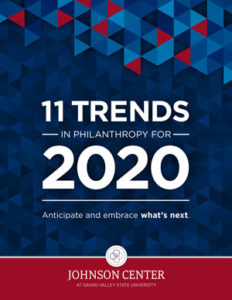Increased Attention to Sustainable Development Goals


In the midst of this global pandemic, the goals may offer a guide for nonprofits and funders questioning how to prioritize their response to immediate needs and how to plan for an uncertain future. This blog from the UN’s Department of Global Communications highlights how different goals relate to the ongoing crisis.
In the piece below, from our 11 Trends in Philanthropy for 2020 report, Jamie DeLeeuw and Teri Behrens outline the current state of funding and coordinated efforts to achieve the goals.
 In May 2018, Kanye West set off an unusual internet firestorm. Seemingly out of nowhere, West shared a tweet with his 28 million followers, “The United Nations introduced the Sustainable Development Goals and platform in 2015 to transform the world by 2030” (Gharib, 2018). Across the Twitter-sphere many people, especially those in organizations doing the work to achieve these goals, debated the tweet’s value. Was West’s message a throw-away comment, or could his influence as a celebrity help bring attention to these global efforts? (Gharib, 2018).
In May 2018, Kanye West set off an unusual internet firestorm. Seemingly out of nowhere, West shared a tweet with his 28 million followers, “The United Nations introduced the Sustainable Development Goals and platform in 2015 to transform the world by 2030” (Gharib, 2018). Across the Twitter-sphere many people, especially those in organizations doing the work to achieve these goals, debated the tweet’s value. Was West’s message a throw-away comment, or could his influence as a celebrity help bring attention to these global efforts? (Gharib, 2018).
In 2015, the United Nations (U.N.) members adopted the Sustainable Development Goals (SDGs), also known as Global Goals. The SDGs are a set of 17 interconnected goals that ideally would lead to all people having a viable future and a significant quality of life by 2030. The goals, which focus on the eradication of extreme poverty and inequality, and climate improvement, comprise 169 targets and 232 indicators to measure impact (United Nations, 2019). The SDGs are a more transformative and comprehensive successor to the U.N.’s Millennium Development Goals that originated in 2000 (ICLEI, 2015).
Whether or not West’s tweet had a measurable impact on public interest or progress on these goals, it is clear that philanthropy is increasing its investment in these efforts and in the public’s awareness. Between 2010 and 2015, foundations worldwide spent an average of $34.3 billion annually on global initiatives that aligned with SDG goals (SDGFunders by Candid, 2019). That number increased considerably following the adoption of the SDGs. Between 2016 and 2019, foundations spent an average of $39.8 billion annually ($159 billion total), with a few weeks remaining in 2019 at the time of this writing (SDGFunders by Candid, 2019).
While this $5.5 billion annual funding increase can’t be directly attributed to the adoption of the SDGs, it does provide evidence that philanthropists have increased their investment in SDG-related initiatives. Since 2016, the top foundations dispersing funds worldwide include the global development heavy hitter, Bill & Melinda Gates Foundation ($12.8 billion), Fidelity Charitable ($4.6 billion), and Gothic Corporation ($3.4 billion), formed to support the tax-exempt intentions of Duke University. Philanthropic dollars have most heavily supported the goals of Quality Education ($64.3 billion); Good Health and Well-Being ($50.7 billion); and Peace, Justice, and Strong Institutions ($16.0 billion) (SDGFunders by Candid, 2019).1
While private foundations doing international grantmaking have been among the biggest users of the SDG framework, the Council on Foundations’ report about the relevance of the SDGs for community foundations is helping draw attention to their value (Ross, 2018). For instance, we are starting to see some community foundations, such as the Southwest Florida Community Foundation, begin to use the SDGs in assessing their work.
Foundations are collaborating amongst themselves and other stakeholders to track philanthropic investments and SDG outcomes to accelerate impact. The SDG Philanthropy Platform is supported by the United Nations Development Programme and Rockefeller Philanthropy Advisors, and provides reports and highlights on current initiatives and regions of focus.
“Foundations are collaborating amongst themselves and other stakeholders to track philanthropic investments and SDG outcomes to accelerate impact.”
SDG Funders grew out of the SDG Philanthropy Platform. Created by Candid (formerly Foundation Center and GuideStar), and funded by the Conrad N. Hilton Foundation, Ford Foundation, and the MasterCard Foundation, it provides tools and captures data primarily from U.S. foundations, to support alignment and report on giving that advances SDG targets. The populations targeted by the grantmaking and region/country of funding source are also available on the site.
Philanthropy is also supporting efforts to keep the public informed about global progress toward these goals. The SDG Tracker is an open-access data visualization tool that allows the public to view SDG goal progress globally and by country. It is a collaboration between researchers at the University of Oxford and the Global Change Data Lab, which publishes Our World in Data (Ritchie, Roser, Mispy, & Ortiz-Ospina, 2019). The data available on the tracker include U.N. statistics and information from other international organizations. Our World in Data has received grant support from the Gates Foundation, Susanne Klatten, and Nuffield Foundation, as well as contributions from sponsors.
Achieving the 17 SDGs by 2030 will require an additional estimated $2.5 trillion annually (SDG Philanthropy Platform, 2019). With the increased attention to the goals and to collecting, analyzing, and sharing data about progress, we may get close to accomplishing some of them.
_______________
1Grants may be counted in the funding totals of multiple SDGs, rendering the calculation of the percentage of overall funding by SDG, inaccurate.


Gharib, M. (2018, May 15). Random tweet from Kanye West about the U.N. baffles the world. Retrieved from https://www.npr.org/sections/goatsandsoda/2018/05/15/611263990/random-tweet-from-kanye-west-about-the-u-n-baffles-the-world
International Council for Local Environmental Initiatives (ICLEI). (2015). From MDGs to SDGs: What are the Sustainable Development Goals? ICLEI Briefing Sheet – Urban Issues, No. 01. Retrieved from https://www.localizingthesdgs.org/library/251/From-MDGs-to-SDGs-What-are-the-Sustainable-Development-Goals.pdf
Nilsson, M., Griggs, D., & Visbeck, M. (2016, June 15). Policy: Map the interactions between Sustainable Development Goals. Nature, 534, 320–322. Retrieved from https://www.nature.com/news/policy-map-the-interactions-between-sustainable-development-goals-1.20075
Our World in Data. (2019). Our supporters. Retrieved from https://ourworldindata.org/supporters
Ritchie, H., Roser, M., Mispy, J., & Ortiz-Ospina, E. (2018). Measuring progress towards the Sustainable Development Goals. Retrieved from https://sdg-tracker.org
Ross, N. (2018). Local leadership, global impact. Retrieved from https://www.cof.org/sites/default/files/documents/files/local-leadership-global-impact.pdf
SDGFunders by Candid. (2019). Who’s funding the SDGs. Sustainable Development Goals. Retrieved from https://sdgfunders.org/sdgs
SDG Philanthropy Platform. (2019). Engaging philanthropy to take actions on the SDGs. Retrieved from https://www.sdgphilanthropy.org
United Nations. (2019). About the Sustainable Developmental Goals. Retrieved from https://www.un.org/sustainabledevelopment/sustainable-development-goals